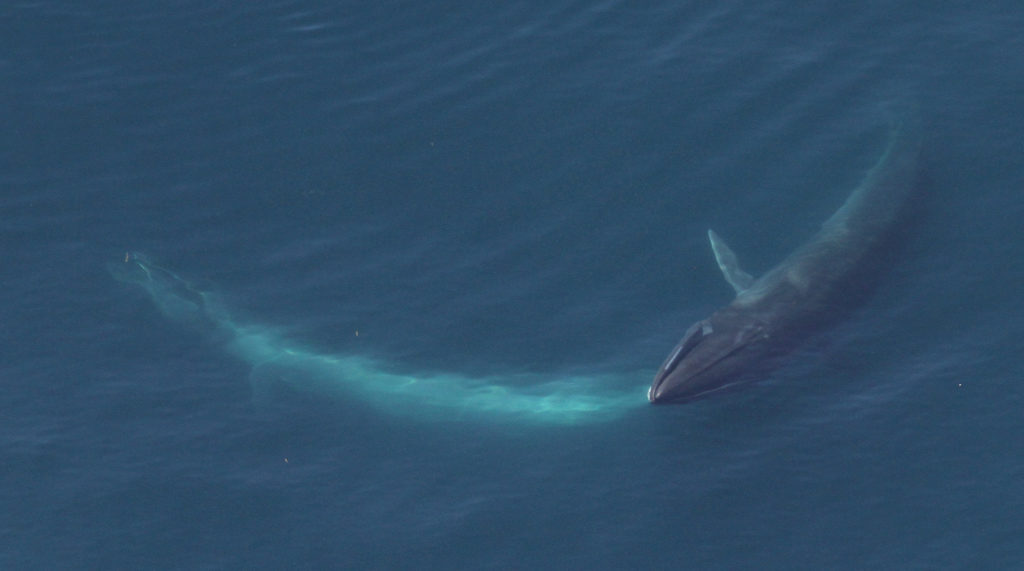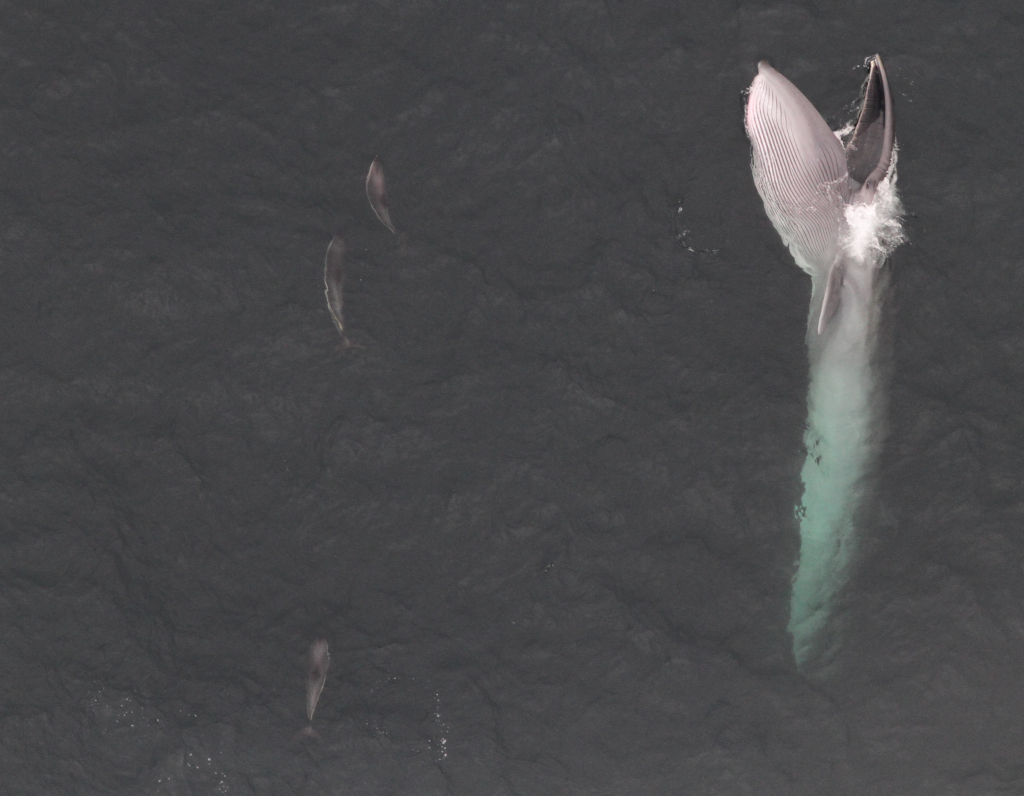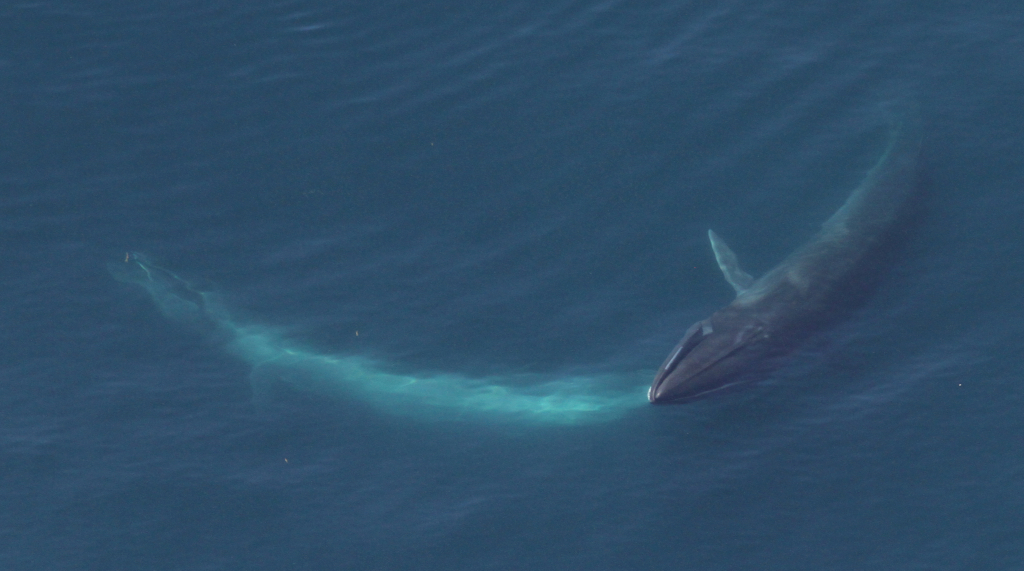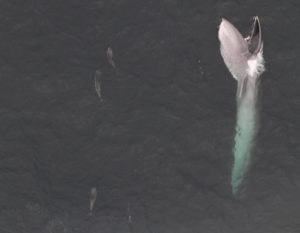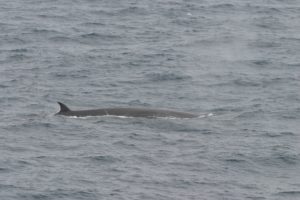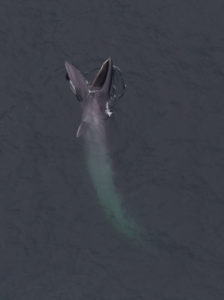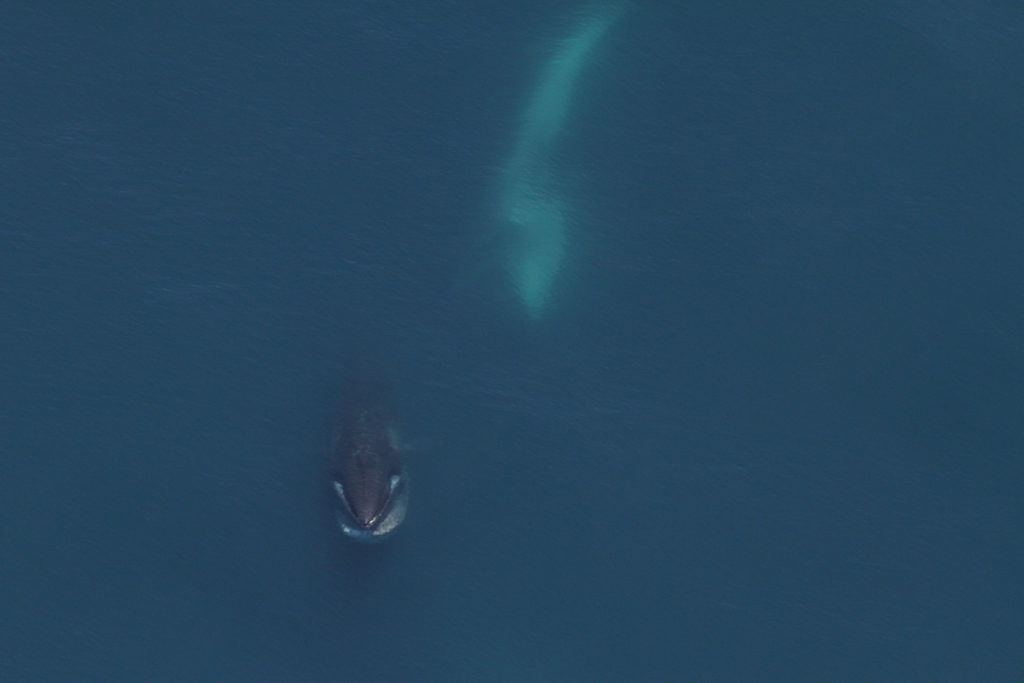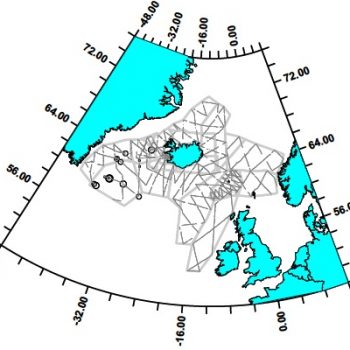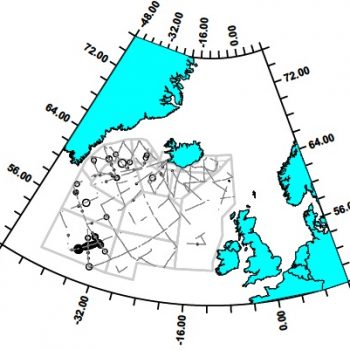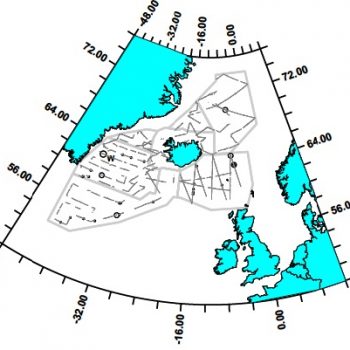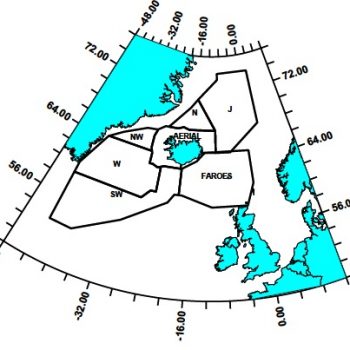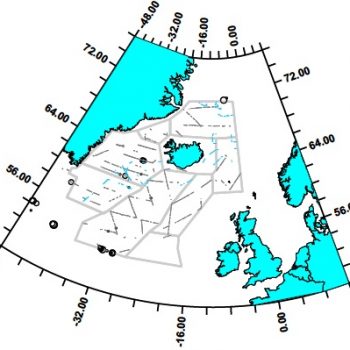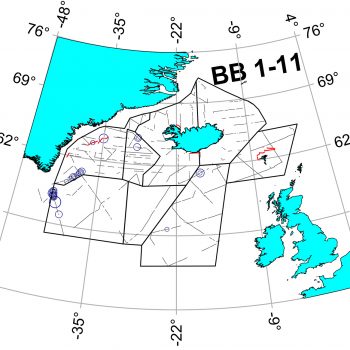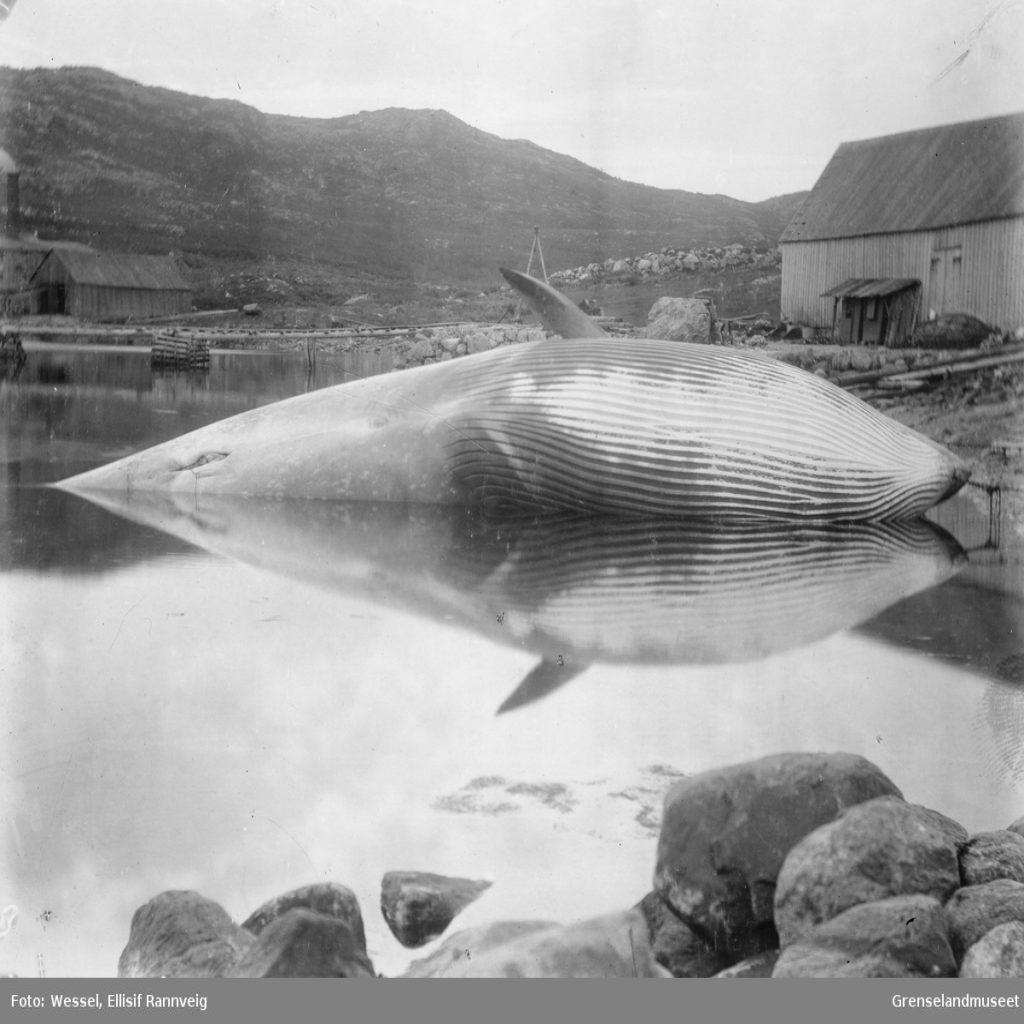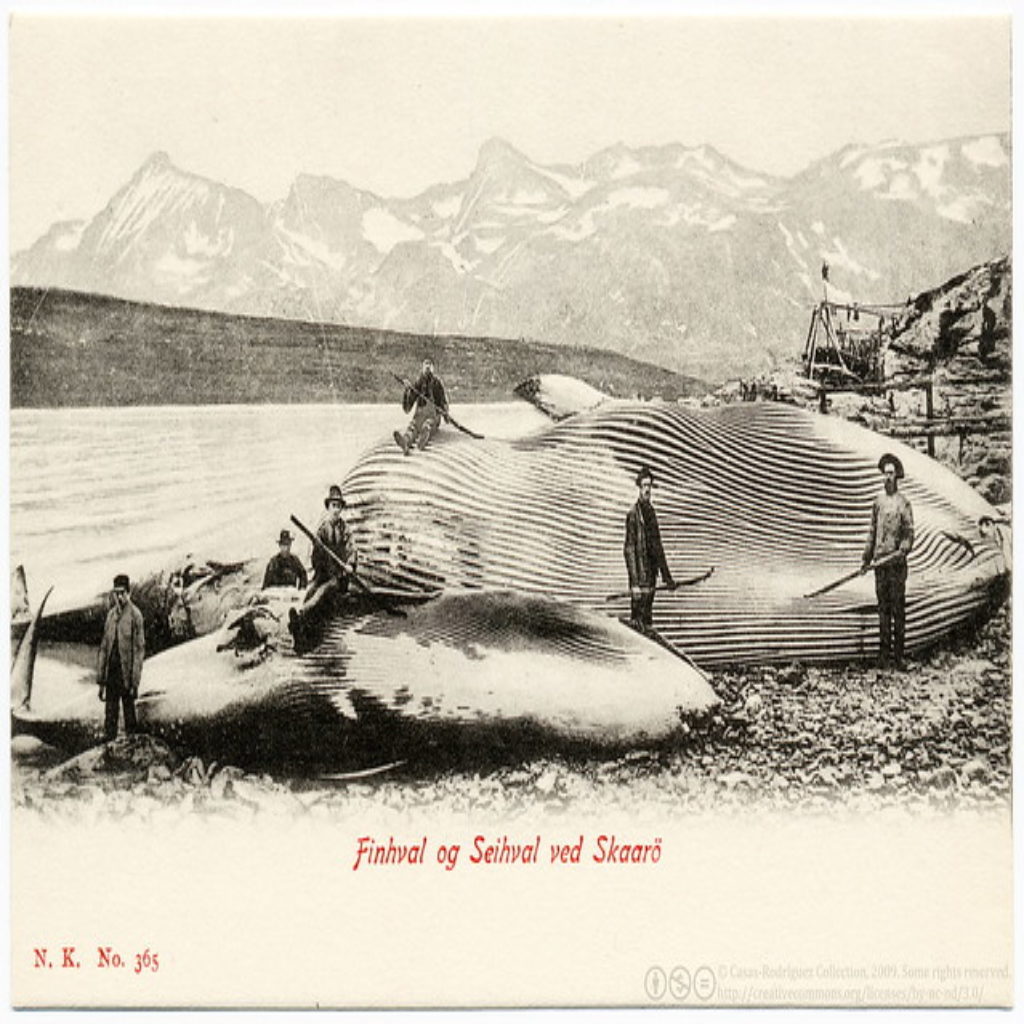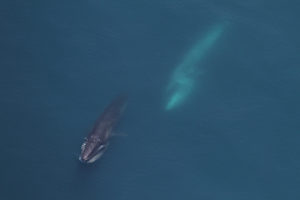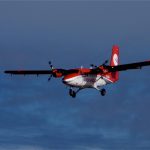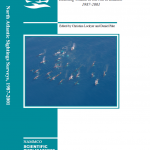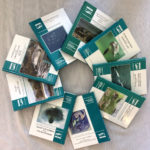Sei Whale
Updated: January 2020
The sei whale is the third largest of the rorquals and closely resembles both the Bryde’s and fin whale. The species has a dark grey colouration dorsally and lighter markings on its underside. It has a more southerly distribution than other large whales found in the North Atlantic and differs from other baleen whales in its ability to utilise different feeding techniques. These different techniques make it much more capable of switching between prey taxa.
The sei whale is predominately found offshore, alone or in small groups. Knowledge about this whale is limited, as its range and distribution do not coincide with most other whales and can fluctuate from year to year.
ABUNDANCE
Recent surveys suggest that there are in excess of 10,000 sei whales in the North Atlantic (Pike et al. 2019a).
DISTRIBUTION
In the North Atlantic, the sei whale is most abundant between West Iceland and Southeast Greenland. It is rare along the Norwegian coast and in British waters.
RELATION TO HUMANS
The sei whale was exploited up until the 1970s, after which it became protected.
CONSERVATION AND MANAGEMENT
There are international management regimes for the sei whale through NAMMCO and the International Whaling Commission.
In the most recent assessment (2023) the species is listed as ‘Least Concern’ in the regional European IUCN Red List and Icelandic national red list, while Norwegian national red list places the species under the ‘Endangered’ category.
Scientific name: Balaenoptera borealis
Faroese: Seihvalur
Greenlandic: Tikaagulliusaarnaq
Icelandic: Sandreyður
Norwegian: Seihval
Danish: Sejhval
English: Sei whale
There are two recognised sub-species of the sei whale. The northern: B. borealis borealis and the southern: B. b. schlegellii.
The name “sei whale” comes from the Norwegian word “sei”, meaning pollock/coalfish. This is because the whale appeared along the Norwegian coast at the same time of year as the fish.
LIFESPAN
50-70 years
AVERAGE SIZE
15 m, 15-20 tonnes (larger in the Southern Hemisphere)
PRODUCTIVITY
1 calf every 2-3 years from 8-10 years years of age
MIGRATION AND MOVEMENTS
Seems to move north in spring and south in autumn
FEEDING
This is area dependent and includes: copepods, euphausiids (krill), other crustaceans and fish.
General characteristics
The sei whale is the fourth largest whale. Of the rorquals, only the fin and blue whales are larger. The sei whale’s dorsal fin is, however, taller than those of either of the other two larger whales. The sei whale closely resembles the Bryde’s whale (B. edeni/brydei) and the two were long thought to be the same species. However, the sei whale has only one distinct ridge on its head, whereas the Bryde’s whale has three (Horwood, 2018). The sei whale is also generally larger. At sea, it can be difficult to distinguish the sei from the Bryde’s whale, and also from the fin whale. To distinguish sei whales from fin whales, survey vessels try to pass these whales on their right-hand side. This is because the fin whale’s head has asymmetrical colouration, with the ventral white colouration extending up over the right lower lip and inside the mouth cavity and baleen plate.
Sei whales have the same general mouth morphology as other rorquals, but they have very fine, silky baleen fringes. This enables them to switch between prey taxa by allowing them to both lunge feed and utilise a surface skim feeding technique (e.g. Ellis 1991, Baumgartner & Fratantoni 2008).
The sei whale is dark grey dorsally with irregular light grey to white markings on its underside. Its body is often scarred from lamprey bites. The sei whales occupying the Southern Hemisphere are generally larger than their northern conspecifics. Icelandic sei whales appear to have an overall greater body weight relative to length than North Pacific sei whales (Lockyer & Waters 1986). As is common with rorquals, females are the larger sex.
Did you know?
Sei whales don’t normally arch their backs and show their tail fluke when diving – they usually just sink below the surface.
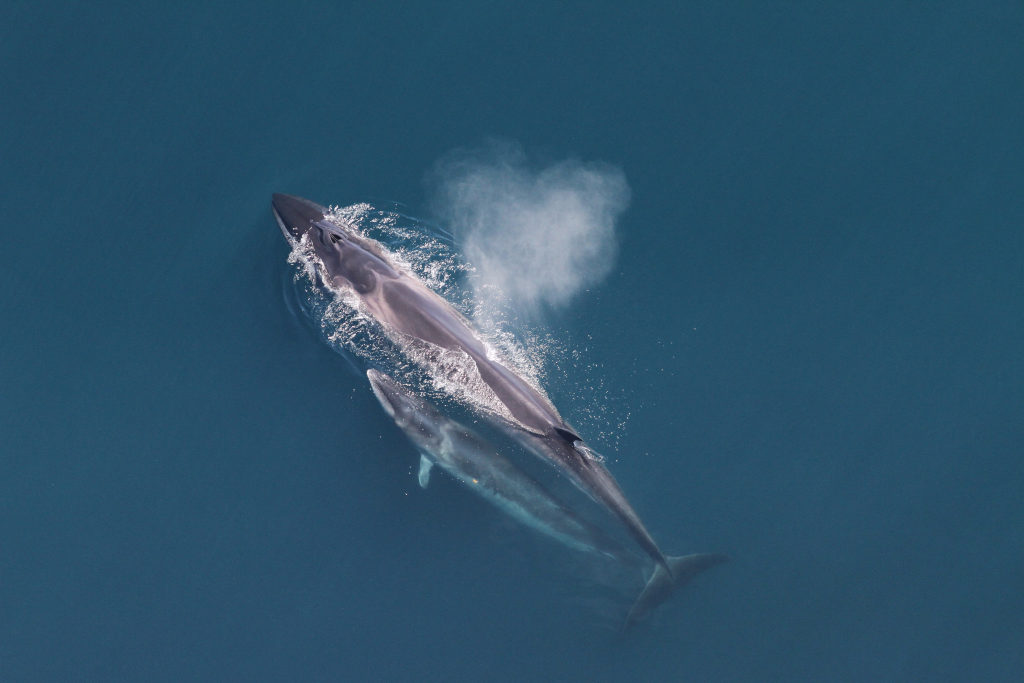
Life History and Ecology
The sei whale is a species for which there is limited knowledge. Research efforts on sei whales have been low compared with other large whales. Most of the current knowledge on this species is based on data from whaling or research focusing on management. Research can be difficult and/or very expensive due to the way this whale utilises a pelagic habitat and is most commonly found offshore, as well as the fact that it is often mistaken for a Bryde’s or fin whale (Prieto et al. 2012, Cooke 2018).
The sei whale seems to prefer offshore and warmer waters than for instance fin, minke and blue whales. It tends to stay in waters with temperatures between 8-18ºC (Cooke 2018). During a survey along the Mid-Atlantic Ridge, sei whales were generally encountered at the slopes of seamounts and rises, in waters with depths between 1,160 and 4,500 m and coinciding with calanoid abundance (Waring et al. 2008).
Lifespan
Sei whales are thought to reach an age of 50 to 70 years.
Reproduction
The sei whale is sexually mature at 8-10 years of age. The average age of maturity for sei whales in most seas declined by 2-3 years after populations were depleted due to whaling. Females usually have one calf every 2-3 years. Conception occurs around December, followed by a gestation period of almost a year. Calves are 4.5 m when born (Sigurjónsson 1997) and are weaned when they are about 7 months old (Horwood 2018).
Feeding
Large whales exhibit different feeding strategies, with some whales lunging for food, while others “cruise along” with their mouths open, skimming water as they go. Uniquely, sei whales exhibit both these strategies, making them able to utilise a broader range of prey than other baleen whales (e.g. Baumgartner & Fratantoni 2008). The sei whale thus has a much more varied diet than the blue whale, for instance. It also appears to feed on different prey items depending on both the area and the season.
Copepods, euphausiids (krill), various fish species, different life stages of several crab species, gastropods (snails) and even squat lobsters have been identified as sei whale prey (e.g. Christensen et al. 1992, Kapel 1979, Leonardi et al. 2011, Sigurjónsson 1997, Sigurjónsson & Vikingsson 1997, Watanabe et al. 2012). Habitat selection based on prey selection has also been suggested, with sei whales utilising the distribution of prey items as a migration route and forage habitat (Watanabe et al. 2012).
In Norwegian, Icelandic and Greenlandic waters, either copepods (mainly Calanus finmarchicus) or euphausiids (krill) seem to be the preferred prey. However Icelandic sei whales also include some fish in their diet (e.g. Christensen et al. 1992, Kapel 1979, Sigurjónsson 1997, Sigurjónsson & Vikingsson 1997). Sei whales off Nova Scotia also seem to prefer copepods and krill, but also show monthly trends in prey items that include various fish species (Flinn et al. 2002, Sigurjónsson 1997). In the southwestern Gulf of Maine, sei whales seem to prefer to feed on C. finmarchicus at or near the surface (Bumgartner et al. 2011).
Behaviour
Sei whales are usually found alone or in small groups. During a summer survey along the Mid-Atlantic Ridge in 2004, most of the groups of sei whales encountered contained 2-5 animals, although a group of up to 10 animals was observed (Waring et al., 2008). In 2015, sei whales observed in Icelandic and Faroese waters were usually solitary or in pairs, but in rare instances they were also seen in groups as large as 8 individuals (Pike et al., 2019a).
Diving/swimming
Sei whales are believed to be the fastest of the large whales, reaching speeds of up to 50 km/h (Shefferly, 1999). They do not dive very deep or long though, and unlike other large whales, they usually just sink below the surface instead of arching their backs and showing their tail fluke (NOAA, n.d.).
Vocalisation
Passive acoustic monitoring is used as an additional tool for management purposes, as recordings of vocalizations in an area are a less expensive way to pinpoint a species to a certain location than the more traditional use of human-manned surveys. It is also possible to deploy these monitoring devices over a longer period than aerial or ship surveys. The only requirement is to change batteries and collect the recordings once or a few times a year. To interpret the recordings, knowledge on the species’ vocalizations is necessary.
Sei whales have been found to make more numerous calls during the day when the copepod C. finmarchicusis at depth than at night when the copepod is in surface waters (Baumgartner & Fratantoni, 2008). This suggests that the availability of this prey item at the surface influences sei whale vocalization behaviour. Previously, these vocalizations were assumed to be connected to social context and not connected to the location of prey.
Sei whale vocalizations recorded off the Azores averaged between 177 and 194 dB, at 20-120 Hz. The call had low-frequency downsweeps with maximum frequencies averaging 100 Hz down to 37 Hz (Romagosa et al., 2015). Downsweeps recorded in the south-eastern Pacific Ocean had a similar range, with an average maximum frequency between 93.3 and 105.3 Hz and an average minimum between 35.6 and 42.2 Hz. The maximum frequency was 129.4 Hz and duration 2.27 s. Calls recorded in Antarctic waters do not show similarities with the calls recorded in the south-eastern Pacific, with frequencies between 100 and 600 Hz and up to 3 s duration (e.g. Español-Jiménez et al., 2018).
Listen to sei whale sounds
Strandings
In 2014, a sei whale was found in a field in Yorkshire (UK), after presumably foraging in shallow waters during high tide. This was the third stranding of a sei whale in 20 years in the UK (“How did a 33ft whale end up in the middle of a field in East Yorkshire?”, 2014).
At least 343 baleen whales, primarily sei whales, were found stranded in remote waters off Patagonia, Chile, in 2015. This is the biggest single baleen whale mass mortality event known to science. Investigations showed that the they died at sea, close to where they beached. There are indications that the cause was a harmful toxic algal bloom caused by a strong El Niño event (Häussermann et al., 2017).
Predators
Like other large baleen whales, the sei whale does not have many natural predators due to its size. However, killer whales are known to also attack large whales.
Distribution and habitat
Worldwide distribution
Sei whales are found throughout the world’s oceans and are present in the North Atlantic, Pacific and Southern Oceans, but there are no records from the Northern Indian Ocean (Cooke 2018). These whales prefer deep water throughout their range. They avoid polar and tropical waters, opting for a temperature range of 8-18ºC (Cooke 2018).
Since the main source of distribution of this species comes from historical whaling records, this may not reflect its entire distribution and might actually no longer be accurate for some areas (Prieto et al. 2012). Their close resemblance to the Bryde’s and fin whale also makes distribution mapping somewhat challenging. The winter distribution, which seems to be widely dispersed, is in particular incomplete.
Distribution in the North Atlantic
The timing and extent of sei whale movements throughout western European waters have always fluctuated between seasons and years. Whalers referred to this variation by talking about “sei whale years” (Prieto et al. 2012). Typically, they occur north to the Davis Strait and the northern end of the Denmark Strait, as well as up to 70º N in the Norwegian Sea, in an arc running from the south of Nova Scotia, via the north-western British Isles to Trondheim in Norway (Cooke 2018).
Central & Eastern North Atlantic
Most sei whale sightings during summer are concentrated in the deep waters between Southeast Greenland and West Iceland, with some in the Faroe-Shetland Channel (Borchers & Burt 1997, Cattanach et al. 1993, Sigurjónsson 1997, Prieto et al. 2012).
In Norwegian and British waters, occurrence is scarce (e.g. Hammond et al. 2013, 2017, Leonard & Øien 2020a,b, Pike et al. 2019a, Rogan et al. 2018). Only a few sightings have been made in Norwegian waters in recent years. Most recently, a single individual was sighted in each of the years 2006, 2014 and 2018 (Øien et al. 2009, Prieto et al. 2012, Leonard et al. 2019). Additionally, sei whales have been sighted infrequently in the Svalbard archipelago, including at the northern tip of Spitzbergen. This is the northernmost record of this species and suggests a possible range expansion (Storrie et al. 2018).
Sei whales have also been detected during acoustic surveys in Irish waters. These detections were rare and only occurred in autumn and especially southwest of the Porcupine Shelf (Berrow et al. 2018). Additionally, 2 sei whales were sighted on the Porcupine Shelf during a winter survey in 2016 (Rogan et al. 2018).
The sei whale was the most commonly encountered species during a survey run along the Mid-Atlantic Ridge between Iceland and the Azores in summer 2004, and all the 53 sightings, totalling 85 animals, were north of the Charlie Gibbs Fracture Zone (Waring et al. 2008).
Further south
Sei whales in low numbers have been observed in late summer and early winter in the Bay of Biscay. They have also been detected in small numbers off north-western Spain. There are discrepancies in historical whaling data from the Iberian Peninsula, indicating that sei whales were never common off central Portugal. Whaling data from the 1970s gives the best indication of a well-defined sei whale wintering area off the Iberian Peninsula (e.g Prieto et al. 2012).
Sei whales have also been shown to be regular visitors to the Azores Archipelago during the spring migration (e.g. Silva et al. 2003, Prieto et al. 2012), with the first record in 1989 (Gordon et al. 1990). Their peak abundance in this area has been shown to be about 16 weeks after the onset of the spring bloom, coinciding with the peak in secondary producers (Visser et al. 2011). This study also recorded sub-adults frequently, indicating an extensive use as a foraging area for females with calves or juveniles.
There is very limited information on sei whales off the western African coast. There have been sporadic sightings and strandings in this area (e.g. Prieto et al. 2012), and one individual was recorded off the Moroccan coast during a sighting survey in April 2005 (Boisseau et al. 2010).
Western North Atlantic
Sei whales were considered rare in the Western North Atlantic during the whaling years. Currently, they seem to be present in low densities in most of the areas covered by dedicated sighting surveys. In Greenland, sightings are concentrated off Lille Hellefiske in the southwest as well as off the southwestern tip of the island. In Canada, sei whales have been confirmed in the Davis Strait and the continental shelf areas along the coasts of Labrador and Newfoundland. Off the north-eastern US coast, they tend to concentrate in deeper waters, taking only occasional trips into shallower waters (e.g. Prieto et al. 2012).
Migrations and movements
Like other large whales, sei whales are thought to undertake seasonal migrations from low to high latitudes, using the latter as a summer feeding ground and the former as a wintering area (e.g. Prieto et al. 2012). Migration routes are poorly known though and sei whales seem to exhibit an often irregular migration pattern. There are, however, indications that they breed in warmer waters close to the Equator (Ellis 1991).
In the period June-September 1979-1985, sei whales were seen in August west and southwest of Iceland, at the same time that blue, fin and humpback whales were leaving the area (Sigurjónsson 1997).
In 2005, a large number of sei whales were sighted off southeast and southwest Greenland. These were likely roaming animals from a larger North Atlantic population that in some years reach these waters (Boertmann 2007).
A presumed “foraging hotspot” was found around the Charlie Gibbs Fracture Zone along the Mid-Atlantic Ridge, coinciding with areas of high calanoid abundance (Waring et al. 2008).
Azores – Labrador
Sei whales in the Azores have been equipped with satellite tags and all whales tagged during spring and early summer moved to the Labrador Sea. This indicates a clear migratory corridor between these two areas (Prieto et al. 2014). This supported the results of the tagging of one whale by Olsen et al. (2009) that showed the same migration route. However, the former results indicated no foraging behaviour during the migration until they reached the Labrador Sea, whilst the latter observed feeding behaviour along the Mid-Atlantic Ridge. The whale tagged by Olsen et al. (2009) also seemed to be closely associated with oceanographic features, “hitching a ride” on the ocean current conveyor belts on its way to the Labrador Sea.
North Atlantic stocks
Little is known regarding the stock identity of sei whales within the North Atlantic. Three stocks are currently recognized by the IWC:
- Nova Scotia (including the waters off eastern USA);
- Iceland-Denmark Strait; and
- Eastern (including the waters of Spain, Portugal, British Isles, the Faroe Islands and Norway).
These divisions were, however, chosen on largely arbitrary grounds, mainly based upon historical catch and sightings data and a desire to match ICES boundaries (Donovan 1991). Sei whales have also been observed in the West Greenland-Labrador Sea, an area not assigned to any of these stocks (Cooke 2018).
Genetic comparisons of sei whales from different North Atlantic locations found no evidence for population structure (Huijser et al. 2018). This is consistent with the extensive range of movement observed in satellite tagged sei whales. However, due to the high uncertainty of the genetic divergence estimates, the potential for distinct populations can not be completely ruled out.
Sei whales from the North Atlantic have been shown to be genetically distinct from those of the North Pacific and the Southern Hemisphere (Husijer et al. 2018).
Current abundance and trends
Recent surveys suggest that there are in excess of 10,000 sei whales in the North Atlantic, but this number should be considered a minimum (Pike et al. 2019a). Pre-whaling levels have been estimated at around 20,000 individuals (Sigurjónsson 1997).
Globally
There are indications that the global population of mature individuals has recovered to around 30% of the level in 1948. This means the global status of the sei whale is considered by the IUCN to be at the border between Endangered and Vulnerable. The current number of mature individuals is estimated to be around 50,000 globally (Cooke 2018).
Eastern North Atlantic
There have been several surveys in the Central Eastern North Atlantic since the 1980s. However, most of these surveys have not been optimised for the sei whale and do not coincide with peak abundance of sei whales in the area as they are run earlier and further north than the primary summer distribution area for sei whales. Thus far, only one survey has run later in the season and further south – the North Atlantic Sightings Survey in 1989. This survey resulted in an estimate of 10,300 sei whales (95% CI: 6,150 – 17,260) for the Icelandic and Faroese area (Cattanach et al. 1993). The survey in 1995 yielded an estimate of 9,249 sei whales (95% CI: 3,700 – 23,116), which could suggest a northward shift in distribution (Borchers & Burt 1997). However, this surprisingly high estimate could also be attributed to high fluctuations in sei whale abundance and distribution (e.g. Pike et al. 2011, 2019) in what are referred to as “sei whale years” (NAMMCO 2019). These are years in which the numbers of sei whales seen in northern areas are dramatically higher than in other years. This indicates temporal variation in their migration patterns.
The latest survey, run in 2015, resulted in an estimate of 3,767 animals (95% CI 1,156-12,270) for the Central North Atlantic (Iceland and the Faroe Islands) (Pike et al. 2019a, NAMMCO 2019).
Most surveys run in Norwegian, UK, Irish and European waters have yielded too few sightings for an abundance estimate (e.g. Hammond et al. 2013, 2017; Leonard & Øien 2020a,b, Pike et al. 2019b, Rogan et al. 2018). However, one survey run in the European Atlantic in 2007 gave an estimate of 366 sei whales (95% CI: 176 – 762), with sightings limited to the survey block off Spain (Macleod et al. 2009).
All available abundance estimates
| Area | Year | Estimate | 95% Confidence Interval (CI) | CV | Source | Comment |
|---|---|---|---|---|---|---|
| Central NA | 1987 | 1,293 | 434-3,853 | 0.60 | Cattanach et al. 1993 | Did not extend far south, resulting in a low estimate |
| 1989 | 10,300 | 6,150-17,260 | 0.27 | Cattanach et al. 1993 | More sei whale specific survey (later in the season and further south) | |
| 1989 | 1,590 | N/A | 0.60 | Cattanach et al. 1993 | The same survey as the previous, only without the southern blocks | |
| 1995 | 9,249 | 3,700-23,116 | N/A | Borchers and Burt 1997 | Surprisingly high estimate, perhaps a “sei whale year” | |
| 2001 | 1,494 | 843-2,245 | 0.24 | Pike et al. 2011 | High certainty estimate, uncorrected | |
| 2007 | 5,159 | 1,983-13,423 | 0.47 | Pike et al. 2019b | T-NASS core area, not corrected for bias | |
| 2007 | 9,737 | 4,189-19,665 | N/A | Pike et al. 2019b | T-NASS core area + extension vessels, uncorrected. 97% of sightings in the extension areas were made southwest of Iceland. | |
| 2015 | 3,767 | 1,156-12,270 | 0.54 | Pike et al. 2019a, NAMMCO 2019 | Corrected estimate | |
| European Atlantic | 2007 | 366 | 176-762 | 0.33 | Macleod et al. 2009 | The first corrected for this area estimates (corrected for g(0) and responsive movement) |
Western North Atlantic
Estimates based on sightings made along the eastern US coast and southern Nova Scotia in 2010-2014 were as follows (Palka et al., 2017):
Spring: 6,293 (CV=1.02, 95% CI: 1,209-32,733)
Summer: 1,872 (CV=0.42, 95% CI: 849-4,129)
Autumn: 2,489 (CV=0.49, 95% CI: 1,006-6,158)
There are no other available abundance estimates for Canadian waters due to too few sightings during surveys (e.g. Lawson & Gosselin, 2009, 2018).
Stock status
As yet, no assessment has been performed by NAMMCO for sei whales in the North Atlantic. This is in part due to a lack of abundance estimates for the whole area.
The Greenlandic Red List (2007) lists the species as Data deficient.
The Icelandic Red List (2018) lists the species as Least Concern.
The Norwegian Red List (2015) list the species as Not assessed, too small population.
STATUS ACCORDING TO OTHER INTERNATIONAL ORGANISATIONS
The Committee on the Status of Endangered Wildlife in Canada (COSEWIC) listed the sei whale as Endangered in May 2019, when it was reassessed from its status as “Data Deficient” from 2003. This species is also listed as endangered by the Canadian Species at Risk Act (SARA).
The Convention on the Conservation of Migratory Species of Wild Animals (CMS) lists the sei whale on its Appendix I – Endangered migratory species and Appendix II – Migratory species conserved through Agreements.
The Convention on International Trade in Endangered Species of Wild Fauna and Flora (CITES) has the species in its Appendix I, which lists species that are the most endangered among CITES-listed animals and plants. This includes species threatened with extinction for which CITES prohibits international trade in specimens, with the exception of when the import is not for commercial purposes.
The International Whaling Commission (IWC) has not carried out an assessment due to “Insufficient data for assessment”. They note that “Surveys reveal little sign of recovery in the Northeastern Atlantic” (IWC n.d.).
The IUCN Global Red List (2018) classifies the species as Endangered, but increasing, bordering on Vulnerable (Cooke 2018).
The IUCN Red List for Europe (2007) classifies the sei whale as Endangered with unknown population trend (IUCN 2007).
Management
Sei whales fall under the management regimes of both the International Whaling Commission, and, since its inception in 1992, NAMMCO.
Sei whales are currently protected in all NAMMCO member countries.
The sei whale has been protected from commercial whaling by the IWC since 1975 in the North Pacific and 1979 in the Southern Hemisphere, as well as through the IWC’s moratorium on whaling since 1986 (Cooke 2018). However, the moratorium does not include catches for scientific research purposes
.
Hunting and utilisation
Historically
When the blue and fin whale stocks were depleted, hunters started focusing their efforts on sei whales (Ellis 1991, Prieto et al. 2012). The species was hunted until the 1970s, although this was at a much lower level in the Central than in the Northeast Atlantic (IWC n.d., Cooke 2018).
Since the 1860s, and up until the IWC’s moratorium on commercial whaling was implemented in the 1980s, about 16,000 sei whales were landed in the North Atlantic. The peaks were around the turn of the century (more than 1,200/year) with a few hundred catches during the years after that (Sigurjónsson 1995). These numbers do not, however, include the high struck and lost rates, which numbered approximately 13,000 unspecified large whales (Cooke, 2018). The sei whale seems to have been depleted in the Northeast Atlantic, as the majority of landings (nearly 10,000 in Norwegian and British waters, again not counting struck and lost) were taken here (Cooke 2018).
Western North Atlantic
Sei whales were not commonly taken in Western Greenland and the Davis Strait, with only 8 reported catches in the periods 1924-39 and 1946-50. However, it was heavily exploited off Canada especially from the 1960s up until 1972 (IWC n.d., Prieto et al. 2012).
Today/after the moratorium
Except for one sei whale caught in Greenland in 2006, there have been no reported catches in NAMMCO member countries since its inception in 1992. Iceland caught a total of 70 sei whales for scientific research in the 1980s (the IWC list of total catches).
| Year | Area | Type | Catch |
|---|---|---|---|
| 1986 | West Iceland | Special permit (scientific whaling) | 40 |
| 1987 | West Iceland | Special permit (scientific whaling) | 20 |
| 1988 | West Iceland | Special permit (scientific whaling) | 10 |
| 1989 | West Greenland | Aboriginal subsistence hunting | 2 |
| 2006 | West Greenland | Aboriginal subsistence hunting | 1 |
Other human impacts
Entanglements & ship strikes
Although reporting is not yet comprehensive or mandatory, there have been no ship strikes or entanglements involving sei whales reported in NAMMCO areas (NAMMCO’s National Progress Reports, the IWC’s Progress Reports). There are, however, records of both entanglements and ship strikes in the Western North Atlantic, i.e. US and Canadian waters (e.g. Henry et al. 2014, Laist et al. 2001, the IWC’s Progress Reports).
Given the sei whale’s offshore distribution, entanglements and ship strikes could be less of a concern for this species than species that frequent areas with high fishing activity and/or shipping lanes. However, ship strikes could go unnoticed due to both the sei whale’s negative buoyancy (making them sink when dead), and the lack of visibility immediately in front of ships. There have been reports of dead sei whales being detected only when the ship arrived at port with the whale on its bow (Laist et al. 2001).
Noise
As other whales do, sei whales use vocalisations for communication and, perhaps, underwater navigation and prey location. Increased noise from shipping traffic, seismic surveys and military sonars could all have an impact on sei whales. Disturbance from noise could, among other things, lead to behaviour alterations (e.g. fleeing, diving, cessation of feeding) or to damage to the ears, causing temporary or permanent loss of hearing.
Persistent organic pollutants
Persistent organic pollution levels in sei whales are not known. However, as for other marine mammal species, such pollution has the potential to impact reproduction and limit the recovery of certain populations.
Climate change
El Niño is a naturally occurring weather pattern that primarily impacts the equatorial Pacific, but that can also affect climate patterns elsewhere. A warming climate seems to affect the intensity of El Niño events, thus also enhancing their impact (Fasullo et al. 2018).
There are indications that the cause of the biggest single baleen whale mass mortality event was a harmful toxic algaal bloom caused by the intense El Niño event of 2014-2016. At least 343 baleen whales, primarily sei whales, were found stranded in remote waters in Chile. Investigations showed that they died at sea, close to where they beached. This has been interpreted as an indication that marine mammals may be among the first oceanic megafauna victims of climate change (Häussermann et al. 2017).
Warming oceans as an affect of climate change also has the potential to affect prey distribution, in turn altering sei whale distribution and/or causing a lack of prey or shift in diet.
Research in NAMMCO member countries
There is currently no active research on the sei whale in NAMMCO member countries. However, sei whale sightings during the North Atlantic Sightings Surveys (NASS) are recorded. This has provided the basis for several recent abundance estimates in the Central North Atlantic (e.g. Pike et al., 2011, 2019a,b). As these latest surveys have only covered parts of the sei whale distribution area, and not the core range, these estimates are only partial. See also 6. Current Abundance and Trends.
Despite limited research on the sei whale in the NAMMCO area, the sei whale’s status is regularly discussed in NAMMCO Working Groups as well as at the annual meeting of the Scientific Committee.
Baumgartner, M.F. and Fratantoni, D.M. (2008). Diel periodicity in both sei whale vocalization rates and the vertical migration of their copepod prey observed from ocean gliders. Limnology and Oceanography, 53(5, part 2), 2197-2209. https://doi.org/10.4319/lo.2008.53.5_part_2.2197
Berrow, S.D., O’Brien, J., Meade, R., Delarue, J., Kowarski, K., Martin, B., Moloney, J., Wall, D., Gillespie, D., Leaper, R., Gordon, J., Lee, A. and Porter, L. (2018). Acoustic Surveys of Cetaceans in the Irish Atlantic Margin in 2015–2016: Occurrence, distribution and abundance. Department of Communications, Climate Action & Environment and the National Parks and Wildlife Service (NPWS), Department of Culture, Heritage and the Gaeltacht, Dublin, Ireland, 348pp. Retrieved from: https://www.dccae.gov.ie/en-ie/natural-resources/topics/Oil-Gas-Exploration-Production/observe-programme/Pages/ObSERVE-Programme.aspx
Boertmann, D. (2007). Grønlands Rødliste – 2007 [Greenlandic Red List]. Danmarks Miljøundersøgelser og Grønlands Hjemmestyre. Retrieved from https://www2.dmu.dk/Pub/Groenlands_Roedliste_2007_DK.pdf
Boisseau, O., Lacey, C., Lewis, T., Moscrop, A., Danbolt, M. and McLanaghan, R. (2010). Encounter rates of cetaceans in the Mediterranean Sea and contiguous Atlantic area. Journal of the Marine Biological Association of the United Kingdom, 90(8), 1589-1599. https://doi.org/10.1017/S0025315410000342
Borchers, D. and Burt, M. (1997). Sei and fin whale abundance in the North Atlantic, estimated from NASS-95 shipboard survey data. SC/5/AE/1 for the NAMMCO Scientific Committee.
Cattanach, K.L., Sigurjonsson, J., Buckland, J. and Gunnlaugsson, T. (1993). Sei whale abundance in the North Atlantic, estimated from NASS-87 and NASS-89 data. Reports of the International Whaling Commission, 43, 315-321.
Christensen, I., Haug, T. and Øien, N. (1992). A review of feeding and reproduction in large baleen whales (Mysticeti) and Sperm whales Physeter macrocephalus in Norwegian and adjacent waters. Fauna Norvegica Serie A, 13, 39-48
Cooke, J.G. (2018). Balaenoptera borealis. The IUCN Red List of Threatened Species 2018: e.T2475A130482064. http://dx.doi.org/10.2305/IUCN.UK.2018-2.RLTS.T2475A130482064.en. Downloaded on 04 June 2019.
Donovan, G.P. (1991). A review of IWC stock boundaries. Reports of the International Whaling Commission, 13, 39-68.
Ellis, R. (1991). Men and Whales. New York: Alfred A. Knopf, Inc.
Español-Jiménez, S., Bahamonde, P.A., Chiang, G. and Häussermann, V. (2018). Discovering sounds in Patagonia: characterizing sei whale (Balaenoptera borealis) downsweeps in the south-eastern Pacific Ocean. Ocean Science, 15, 75-82. https://doi.org/10.5194/os-15-75-2019
Fasullo, J. T., Otto-Bliesner, B. L. and Stevenson, S. (2018). ENSO’s changing influence on temperature, precipitation, and wildfire in a warming climate. Geophysical Research Letters, 45, 9216-9225. https://doi.org/10.1029/2018GL079022
Flinn, R.D., Trites, A.W., Gregr, E.J. and Perry, R.I. (2002). Diets of fin, sei, and sperm whales in British Columbia: an analysis of commercial whaling records, 1963-1967. Marine Mammal Science, 18(3),663-679. https://doi.org/10.1111/j.1748-7692.2002.tb01065.x
Gordon, J., Steiner, L. and Gonçales, J.M. (1990). Sei whales (Balaenoptera borealis) encountered in the Azores: a new record for the regions. Arquipélago Life and Marine Sciences, 8, 97-100.
Hammond, P. S., Lacey, C., Gilles, A., Viquerat, S., Boerjesson, P., Herr, H., … and Scheidat, M. (2017). Estimates of cetacean abundance in European Atlantic waters in summer 2016 from the SCANS-III aerial and shipboard surveys. Wageningen Marine Research. Available at https://synergy.st-andrews.ac.uk/scans3/files/2017/04/SCANS-III-design-based-estimates-2017-04-28-final.pdf
Hammond, P. S., Macleod, K., Berggren, P., Borchers, D. L., Burt, M. L., Cañadas, A., … and Vázquez, J. A. (2013). Cetacean abundance and distribution in European Atlantic shelf waters to inform conservation and management. Biological Conservation, 164, 107-122. https://doi.org/10.1016/j.biocon.2013.04.010
Häussermann, V., Gutstein, C.S., Bedington, M., Cassis, D., Olavarria, C., Dale, A.C., Valenzuela-Toro, A.M., Perez-Alvarez, M.J., Sepúlveda, H.H., McConnell, K.M., Horwitz, F.E. and Försterra, G. (2017). Largest baleen whale mass mortality during strong El Niño event is likely related to harmful toxic algal bloom. PeerJ, 5, e3123. https://doi.org/10.7717/peerj.3123
Henry, A.G., Cole, T.V.N., Hall, L., Ledwell, W., Morin, D. and Reid, A. (2014). Mortality determinations for baleen whale stocks along the Gulf of Mexico, United States east coast, and Atlantic Canadian provinces, 2008 – 2012. US Dept Commer, Northeast Fish Sci Cent Ref Doc. 14-10; 17 p. Available from http://www.nefsc.noaa.gov/nefsc/publications
Horwood, J. (2018). Sei whale. In Würsig, B., Thewissen, J.G.M. and Kovacs, K.M. (Eds.), Encyclopedia of Marine Mammals (3rd ed., pp. 110-114). London (UK): Academic Press.
How did a 33ft whale end up in the middle of a field in East Yorkshire? (2014, 8 December). Daily Mail. Retrieved from: https://www.dailymail.co.uk/news/article-2043105/How-did-Sei-whale-beached-middle-field-East-Yorkshire.html
Huijser, L.A.E., Bérubé, M., Cabrera, A.A. et al. (2018). Population structure of North Atlantic and North Pacific sei whales (Balaenoptera borealis) inferred from mitochondrial control region DNA sequences and microsatellite genotypes. Conservation Genetics. https://doi.org/10.1007/s10592-018-1076-5
International Whaling Commission (IWC). (n.d.). Status of whales. Retrieved from: https://iwc.int/status
International Union for Conservation of Nature (IUCN). (2007). Species account by IUCN SSC Cetacean Specialist Group; regional assessment by European Mammal Assessment team 2007. Balaenoptera borealis. The IUCN Red List of Threatened Species 2007: e.T2475A9444871. Downloaded on 13 August 2019
Kapel, F.O. (1979). Exploitation of Large Whales in West Greenland in the Twentieth Century. Reports of the International Whaling Commission, 29, 197-214
Laist, D.W., Knowlton, A.R., Mead, J.G., Collet, A.S. and Podesta, M. (2001). Collisions between ships and whales. Marine Mammal Science, 17(1), 35-75.
Leonard, D. and Øien, N. (2020a). Estimated Abundances of Cetacean Species in the Northeast Atlantic from Two Multiyear Surveys Conducted by Norwegian Vessels between 2002–2013. NAMMCO Scientific Publications, 11. https://doi.org/10.7557/3.4695
Leonard, D. and Øien, N. (2020b). Estimated Abundances of Cetacean Species in the Northeast Atlantic from Norwegian Shipboard Surveys Conducted in 2014–2018. NAMMCO Scientific Publications, 11. https://doi.org/10.7557/3.4694
Leonardi, M.S., Grandi, M.F., Garcia, N.A., Svendsen, G., Romero, M.A., Gonzáles, R. and Crespo E.A. (2011). A stranding of Balaenoptera borealis (Lesson 1828) from Patagonia, Argentina, with notes on parasite infestation and diet. African Journal of Marine Science, 33(1), 177-179. https://doi.org/10.2989/1814232X.2011.572384
Lawson, J.W. and Gosselin, J.-F. (2009). Distribution and preliminary abundance estimates for cetaceans seen during Canada’s marine megafauna survey – A component of the 2007 TNASS. DFO Canadian Science Advisory Secretariat. Res. Doc. 2009/031. vi + 28 p. http://www.dfo-mpo.gc.ca/csas-sccs/publications/resdocs-docrech/2009/2009_031-eng.htm
Lawson, J. W. and Gosselin, J.-F. (2018). Estimates of cetacean abundance from the 2016 NAISS aerial surveys of eastern Canadian waters, with a comparison to estimates from the 2007 TNASS. SC/25/AE/09 for the NAMMCO Scientific Committee.
Lockyer, C. and Waters, T. (1986). Weights and anatomical measurements of Northeastern Atlantic fin (Balaenoptera physalus, Linnaeus) and sei (B. borealis, Lesson) whales. Marine Mammal Science, 2(3), 169-185.
Macleod, K., Burt, L., Cañadas, A., Lens, S., Rogan, E., Santos, B., Uriarte, A., Van Canneyt, O., Vázquez, J. A. and Hammond, P. S. (2009). Distribution and abundance of fin whales and other baleen whales in the European Atlantic. IWC Scientific Committee Document SC/61/RMP10.
National Oceanic and Atmospheric Administration (NOAA). (n.d.). Sei Whale. Retrieved from https://www.fisheries.noaa.gov/species/sei-whale
North Atlantic Marine Mammal Commission (NAMMCO). (2017a). Marine Mammals: A multifaceted Resource.
North Atlantic Marine Mammal Commission (NAMMCO). (2019). Report of the Abundance Estimates Working Group. October 2019. Tromsø, Norway. https://nammco.no/topics/abundance_estimates_reports/
Olsen, E., Budgell, W.P., Head, E., Kleivane, L., Nøttestad, L., Prieto, R., Silva, M.A., Skov, H., Víkingsson, G.A., Waring, G. and Øien, N. (2009). First Satellite-Tracked Long-Distance Movement of a Sei Whale (Balaenoptera borealis) in the North Atlantic. Aquatic Mammals, 35(3), 313-318. https://doi.org/10.1578/AM.35.3.2009.313
Palka, D.L., Chavez-Rosales, S., Josephson, E., Cholewiak, D., Haas, H.L., Garrison, L., … and Orphanides, C. (2017). Atlantic Marine Assessment Program for Protected Species: 2010-2014. US Dept. of the Interior, Bureau of Ocean Energy Management, Atlantic OCS Region, Washington, DC. OCS Study BOEM 2017-071. 211 pp.
Pike, D. G., Gunnlaugsson, T., Víkingsson, G. A. and Mikkelsen, B. (2011). Estimates of the abundance of sei whales (Balaenoptera borealis) from the NASS Icelandic and Faroese ship surveys conducted in 2001 and 2007. SC/18/AESP/7 for the NAMMCO Scientific Committee.
Pike, D.G., Gunnlaugsson, T., Mikkelsen, B., Halldórsson, S.D. and Víkingsson, G.A. (2019a) Estimates of the abundance of cetaceans in the central North Atlantic based on the NASS Icelandic and Faroese shipboard surveys conducted in 2015. NAMMCO Scientific Publications, 11.
Pike, D.G., Gunnlaugsson, T., Mikkelsen, B., Halldórsson, S.D., Vikingsson, G.A., Acquarone, M. and Desportes, G. (2019b). Estimates of the abundance of cetaceans from the T-NASS Icelandic and Faroese ship surveys conducted in 2007. NAMMCO Scientific Publications, 11.
Prieto, R., Janiger, D., Silva, M.A., Waring, G.T. and Gonçalves, J.M. (2012). The forgotten whale: a bibliometric analysis and literature review of the North Atlantic sei whale Balaenoptera borealis. Mammal Review, 42, 235-272. https://doi.org/10.1111/j.1365-2907.2011.00195.x
Prieto, R., Silva, M.A., Waring, G.T. and Gonçalves, J.M. (2014). Sei whale movements and behaviour in the North Atlantic inferred from satellite telemetry. Endang. Species Research, 26(2), 103-113. https://doi.org/10.3354/esr00630
Rogan, E., Breen, P., Mackey, M., Cañadas, A., Scheidat, M., Geelhoed, S. and Jessopp, M. (2018). Aerial surveys of cetaceans and seabirds in Irish waters: Occurrence, distribution and abundance in 2015-2017. Department of Communications, Climate Action & Environment and National Parks and Wildlife Service (NPWS), Department of Culture, Heritage and the Gaeltacht, Dublin, Ireland. 297pp. https://www.dccae.gov.ie/en-ie/natural-resources/topics/Oil-Gas-Exploration-Production/observe-programme/Pages/ObSERVE-Programme.aspx
Romagosa, M., Cucknell, A.-K., Moscrop, A. and McLanaghan, R. (2015). Source level estimates for sei whale (Balaenoptera borealis) vocalizations off the Azores. Journal of the Acoustical Society of America, 138(4), 2367-2372. http://dx.doi.org/10.1121/1.4930900
Shefferly, N. (1999). “Balaenoptera borealis” (On-line), Animal Diversity Web. Accessed August 13, 2019 at https://animaldiversity.org/accounts/Balaenoptera_borealis/
Silva, M.A., Prieto, R., Magalhães, S., Cabecinhas, R., Cruz, A., Gonçalves, J.M. and Santos, R.S. (2003) Occurrence and distribution of cetaceans in waters around the Azores (Portugal), Summer and Autumn 1999–2000. Aquatic Mammals, 29, 77-83. https://doi.org/10.1578/016754203101024095
Sigurjónsson, J. (1997). On the life history and autecology of North Atlantic rorquals. In Blix, A.S., Walløe, L. and Ulltang, Ø. (eds.) Whales, seals, fish and man (pp. 425-441). Amsterdam: Elsevier Science B.V. https://doi.org/10.1016/S0163-6995(06)80044-2
Sigurjónsson, J. and Vikingsson, G.A. (1997). Seasonal abundance of and Estimated Food Consumption by Cetaceans in Icelandic and Adjacent Waters. Journal of Northwest Atlantic Fishery Science, 22, 271-287. https://doi.org/10.2960/J.v22.a20
Storrie, L., Lydersen, C., Andersen, M., Wynn, R.B. and Kovacs, K.M. (2018). Determining the species assemblage and habitat use of cetaceans in the Svalbard Archipelago, based on observations from 2002 to 2014. Polar Research, 37(1). https://doi.org/10.1080/17518369.2018.1463065
Visser, F., Hartman, K.L., Pierce, G.J., Valavanis, V.D. and Huisman, J. (2011). Timing of migratory baleen whales at the Azores in relation to the North Atlantic spring bloom. Marine Ecology Progress Series, 440, 267-279. https://doi.org/10.3354/meps09349
Waring, G.T., Nøttestad, L., Olsen, E., Skov, H. and Vikingsson, G. (2008). Distribution and density estimates of cetaceans along the mid-Atlantic Ridge during summer 2004. Journal of Cetacean Research and Management, 10(2), 137-146. https://archive.iwc.int/pages/search.php?search=%21collection15&k=
Watanabe, H., Okazaki, M., Tamura, T., Konishi, K., Inagake, D., Bando, T., Kiwada, H. and Miyashita, T. (2012). Habitat and prey selection of common minke, sei and Bryde’s whales in mesoscale during summer in the subarctic and transition regions of the western North Pacific. Fisheries Science, 78, 557-567. https://doi.org/10.1007/s12562-012-0480-x
Weir, C.R. 2023. Balaenoptera borealis (Europe assessment). The IUCN Red List of Threatened Species 2023: e.T2475A221059418. Accessed on 20 December 2023.
Fisheries and Oceans Canada – Sei whale
US National Oceanic & Atmospheric Administration (NOAA) Fisheries – Sei whale
University of Michigan Museum of Zoology Animal Diversity Web – Sei whale
Discovery of Sound in the Sea – Sei whale
IUCN Red List – Sei whale European assessment (2007)
IUCN Red List – Sei whale global assessment (2018)
Greenlandic Red List (in Danish)
Icelandic Red List (in Icelandic)
Norwegian Red List (in Norwegian)
News articles
UK Daily Mail – How did a 33ft whale end up in the middle of a field in East Yorkshire?
National Geographic – 337 Whales Beached in Largest Stranding Ever





